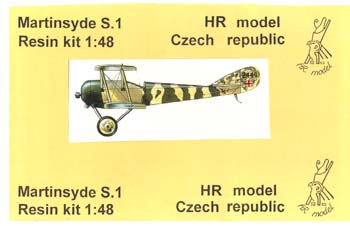HR Models 1/48 Martinsyde S.1 By Bob Pearson | | History
In the First World War, what came to be called 'fighters' in a later
age were known as 'scouts'. This came from their orignal intent, to be
a fast nimble aircraft that could 'scout' over the battlefield and spy
on the enemy. However it soon transpired that enterprising pilots experimented
with various means of arming their aircraft in an attempt to stop the
enemy from observing them, but at the same time allowing one's own side
to watch the enemy unimpeded - the name 'scout' was still used for those
single seat aircraft engaged in such pursuits.
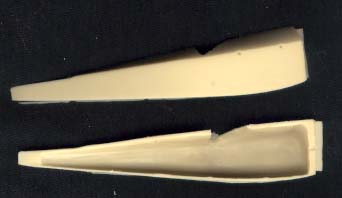 One
of the original scout designs in its original guise was the little Martinsyde
S.1. Later it was to become armed with an overwing Lewis gun and the second
generation of scouts were now born. It was in one of these aircraft with
a Lewis gun mounted that the then 2/Lt LA Strange had what can ony be
termed a very harrowing experience. After engaging an enemy aircraft he
reached up to change drums, finding the drum stuck and with his movement
restricted he loosened his safety belt and stood up with the stick between
his legs to get a better grip. It was at this moment that the Martinsyde
overturned and he was thrown from his aircraft ... One
of the original scout designs in its original guise was the little Martinsyde
S.1. Later it was to become armed with an overwing Lewis gun and the second
generation of scouts were now born. It was in one of these aircraft with
a Lewis gun mounted that the then 2/Lt LA Strange had what can ony be
termed a very harrowing experience. After engaging an enemy aircraft he
reached up to change drums, finding the drum stuck and with his movement
restricted he loosened his safety belt and stood up with the stick between
his legs to get a better grip. It was at this moment that the Martinsyde
overturned and he was thrown from his aircraft ...
Luckily Strange was still holding the drum, which was still attached
to the gun. After a few frantic seconds in which he now prayed that the
drum stay on with even more ardour than he had wished it off, his madly
flailing feet found the airframe and he was able to get back into the
cockpit.
Strange went on to a most successful career in the RAF, and wrote of
his experiences in "Recollections of an Airman".
The Kit 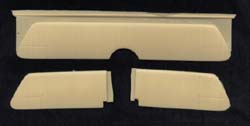 Better known for their 1/72 resin kits, this marks the second (at least) foray into 1/48 for HR Models, their first being the even more obscure PV-7 Grain Kitten. Opening the largish box reveals the usual tan resin in a ziplock baggie. There are 31 resin parts, a piece of clear celluloid for a windscreen and a decal sheet, no metal or photoetch is included. Better known for their 1/72 resin kits, this marks the second (at least) foray into 1/48 for HR Models, their first being the even more obscure PV-7 Grain Kitten. Opening the largish box reveals the usual tan resin in a ziplock baggie. There are 31 resin parts, a piece of clear celluloid for a windscreen and a decal sheet, no metal or photoetch is included. The upper wing has the same texture problem as the fuselage, as do the bottom of the lower wings. The wings are also a tad on the thick side. Both of these 'problems' could benefit from a light sanding and a coat or two of primer.
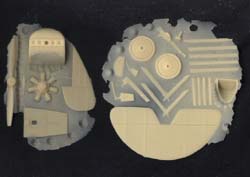 The
surface of one half of the fuselage has a slight 'orange peel effect to
it .. whether this will be apparent under paint remains to be seen, the
other half is smooth. There is ample room inside to detail it to whatever
degree your particular psychosis demands. Included on two wafers are the
following interior details parts: floor, seat, control column, rudder
bar, throttle (mounted on a piece of 'fretted' former). Other deatil parts
include: wheels, propeller, engine, cowl, tail surfaces and struts, and
.. of course .. a Lewis gun. The
surface of one half of the fuselage has a slight 'orange peel effect to
it .. whether this will be apparent under paint remains to be seen, the
other half is smooth. There is ample room inside to detail it to whatever
degree your particular psychosis demands. Included on two wafers are the
following interior details parts: floor, seat, control column, rudder
bar, throttle (mounted on a piece of 'fretted' former). Other deatil parts
include: wheels, propeller, engine, cowl, tail surfaces and struts, and
.. of course .. a Lewis gun.
Decals are provided for Strange's aircraft 2440, which was camouflaged as seen above. Instructions are limited to a three-view drawing, a camouflage drawing and three xeroxed photos, so other sources or best guess will be in order for interior layout. Conclusion 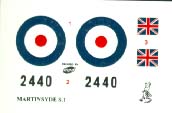 Once the strange (hahaha. . Strange .. get it ..? sorry .. I've been up for the last 36 hours. . ) finish and wings are corrected this will make a fine addition to anyone's 1/48 shelf, and will also send visitors into a frenzy of "What is it? It sorta looks like ....". Once the strange (hahaha. . Strange .. get it ..? sorry .. I've been up for the last 36 hours. . ) finish and wings are corrected this will make a fine addition to anyone's 1/48 shelf, and will also send visitors into a frenzy of "What is it? It sorta looks like ....".
HR Models are to be commended for making aircraft that are out of the ordinary and at a reasonable price. My thanks to Lubos Vinar of VAMP Mail Order for the review sample. | 


 




    |
